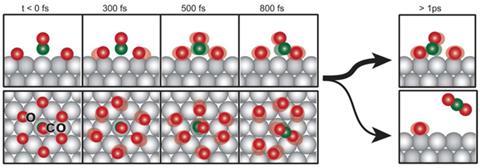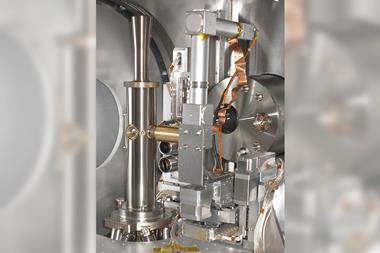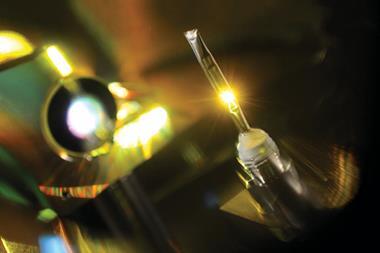Study of femtosecond-timescale carbon monoxide oxidation highlights technique’s potential in catalysis

An international team has made what it believes are the first direct measurements of transition states where separate atoms can form a bond. Using the Linac Coherent Light Source (LCLS) x-ray free-electron laser in Menlo Park, California, they’ve recorded carbon monoxide molecules reacting with oxygen atoms on a ruthenium catalyst over almost impossibly fleeting timespans. ‘To be able to look at fundamental steps in reactions like this opens up a new paradigm for chemistry, particularly catalysis,’ says Stanford University’s Anders Nilsson, the team’s leader.
Nilsson’s team have not collected direct visual images, but x-ray absorption spectroscopy (XAS) data of crucial importance to chemists. They fired x-rays at molecules and atoms adsorbed onto a surface in a vacuum chamber. From the energy of a select portion of the x-rays scattered back the scientists could track how the electronic structure of each adsorbed atom changed as the reaction progressed.
The researchers studied carbon monoxide oxidation on ruthenium – happening right now in automobile catalytic converters everywhere – because so much is already known about the reaction. They knew that optical lasers can trigger the reaction to form carbon dioxide within a few picoseconds – that is, a few trillionths of a second. The x-ray pulses generated by LCLS allow them to study that process because they are over 10 times shorter, lasting 80 femtoseconds. By varying the delay between the optical and x-ray pulses, the scientists collected snapshots to be reassembled later like frames of an animation.
The scientists’ reconstruction shows oxygen atoms starting to move almost immediately, followed by carbon monoxide after around 500fs. By 1ps around 10% of the carbon monoxide molecules have collided with oxygen atoms and formed a transition state. However, most transition state configurations break back down into their starting components.
Christian Bressler from the European x-ray free-electron laser (XFEL) in Hamburg, Germany, calls this ‘a nice piece of hard experimental work’ that achieves ‘truly femtosecond time resolution’. ‘Recording XAS from surfaces is already quite demanding,’ he says, ‘but here the authors recorded the temporal sequence within the very first picosecond.’
Nilsson points out that this experiment wouldn’t have been possible until the advent of x-ray lasers like LCLS, which opened in 2009. He adds that studying even this well-known system took long preparations from several groups, spanning the US, UK, Sweden and Germany. This way of working is taking physical chemistry ‘towards how people do particle physics’, the scientist notes.












No comments yet